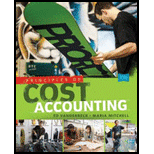
Concept explainers
a.
Provide a
a.
Explanation of Solution
| Materials—2 lb @ $8 | $16 |
| Labor—1 hr @ $10 | $10 |
| Factory | $4 |
| Standard unit cost | $30 |
Figure (1)
b.
Examine the variances for materials and labor.
b.
Explanation of Solution
Calculate material price variance:
Calculate materials quantity variance:
Calculate Labor rate variance:
Calculate labor efficiency variance:
c.
Prepare journal entries.
c.
Explanation of Solution
(1)
| Date | Account Title and Explanation | Debit ($) | Credit($) |
| Work in Process | $16,000 | ||
| Materials Price Variance | $950 | ||
| Materials Quantity Variance | $800 | ||
| Materials | $16,150 | ||
| (to record the entry for direct materials cost when the materials are issued into production) |
Table (1)
(2)
| Date | Account Title and Explanation | Debit ($) | Credit($) |
| Work in Process | $10,000 | ||
| Labor Rate Variance | $180 | ||
| Labor efficiency Variance | $1,000 | ||
| Payroll | $9,180 | ||
| (to record the entry for direct labor cost) |
Table (2)
(3)
| Date | Account Title and Explanation | Debit ($) | Credit($) |
| Work in Process | $4,000 | ||
| Applied Factory overhead | $4,000 | ||
| (to record the entry applying factory overhead to work in process) |
Table (3)
d.
Prepare the
d.
Explanation of Solution
Case 1 and case 2:
| Date | Account Title and Explanation | Debit ($) | Credit($) |
| Finished Goods | $30,000 | ||
| Work in process | $30,000 | ||
| (to record the entry for finished goods at standard cost) |
Table (4)
Want to see more full solutions like this?
Chapter 8 Solutions
Principles of Cost Accounting
 Principles of Cost AccountingAccountingISBN:9781305087408Author:Edward J. Vanderbeck, Maria R. MitchellPublisher:Cengage Learning
Principles of Cost AccountingAccountingISBN:9781305087408Author:Edward J. Vanderbeck, Maria R. MitchellPublisher:Cengage Learning Managerial Accounting: The Cornerstone of Busines...AccountingISBN:9781337115773Author:Maryanne M. Mowen, Don R. Hansen, Dan L. HeitgerPublisher:Cengage LearningPrinciples of Accounting Volume 2AccountingISBN:9781947172609Author:OpenStaxPublisher:OpenStax College
Managerial Accounting: The Cornerstone of Busines...AccountingISBN:9781337115773Author:Maryanne M. Mowen, Don R. Hansen, Dan L. HeitgerPublisher:Cengage LearningPrinciples of Accounting Volume 2AccountingISBN:9781947172609Author:OpenStaxPublisher:OpenStax College


